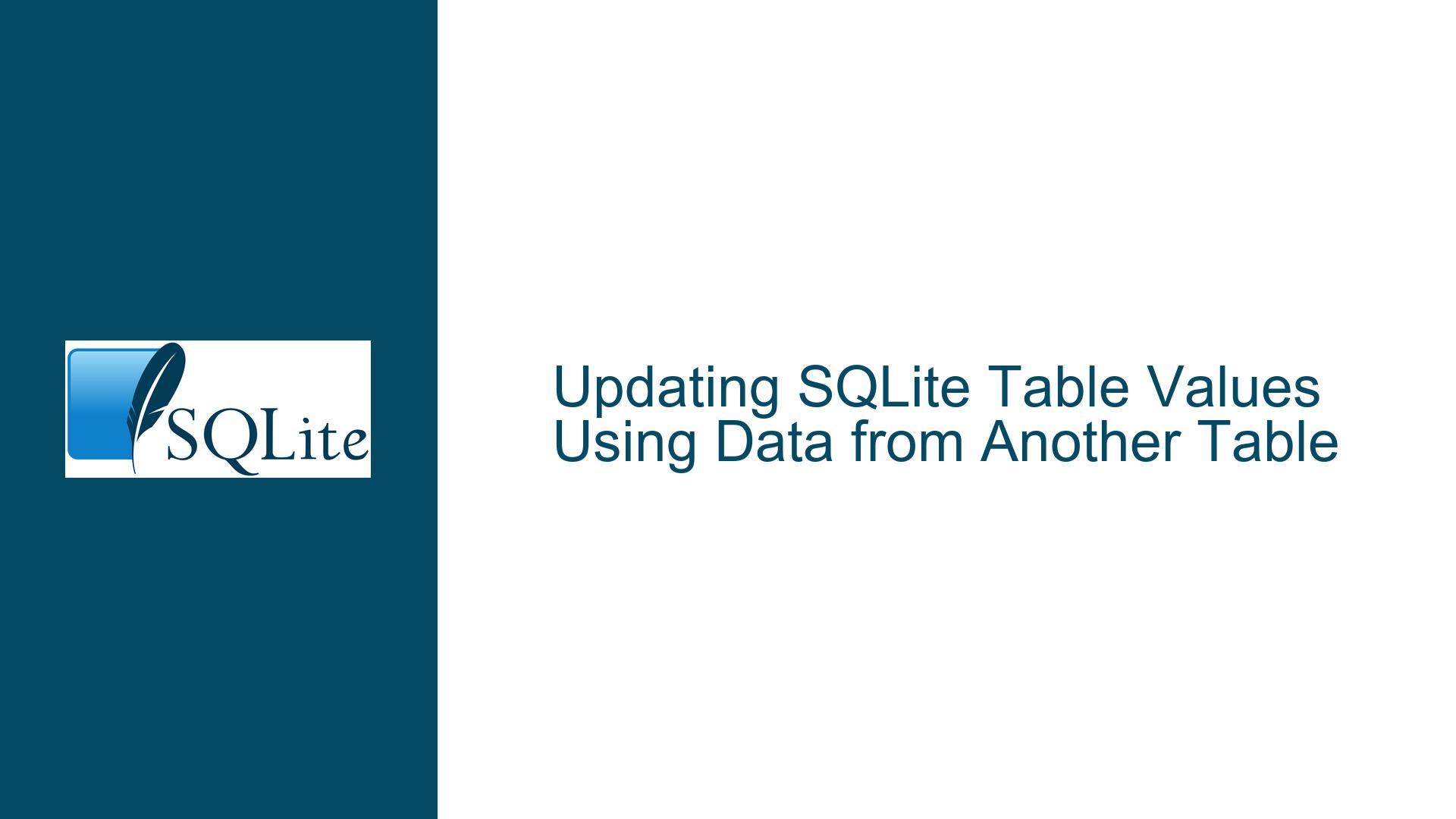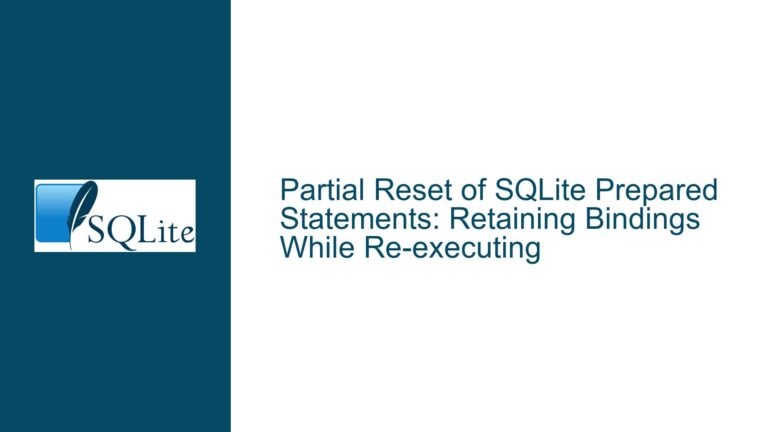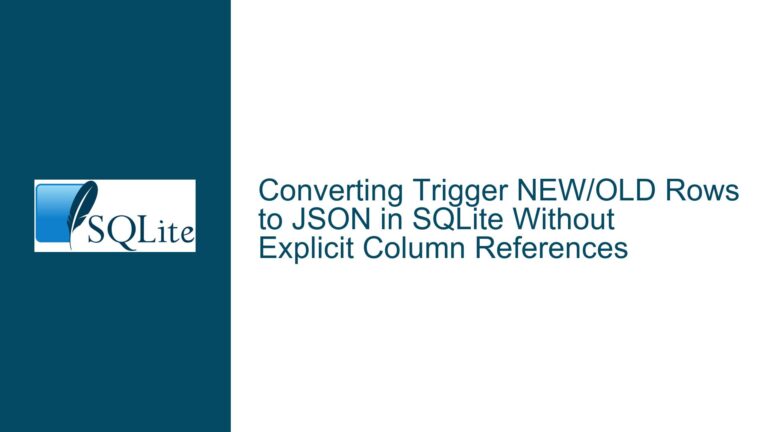Updating SQLite Table Values Using Data from Another Table
Ambiguous Column Errors and Incorrect Updates in SQLite
When working with SQLite, a common task is updating values in one table using data from another table. This operation, while seemingly straightforward, can lead to errors such as "ambiguous column name" or incorrect updates where the wrong values are applied across rows. These issues often stem from misunderstandings of SQLite’s UPDATE syntax, particularly when joining tables or using subqueries.
The error "ambiguous column name: zip.CODE_STAT" typically occurs when the same column name exists in multiple tables referenced in the query, and SQLite cannot determine which instance of the column to use. This ambiguity arises because the query does not explicitly specify the table for the column in question. For example, if both t1 and t2 contain a column named CODE_STAT, SQLite will throw an error unless the column is prefixed with the table name.
Incorrect updates, such as using the value of the first row for all rows, often result from improperly structured subqueries. When a subquery in an UPDATE statement returns more than one row, SQLite may not behave as expected, especially if the query lacks a proper WHERE clause to correlate the rows between the tables. This can lead to all rows in the target table being updated with the same value, which is rarely the desired outcome.
Misuse of Subqueries and Join Syntax in UPDATE Statements
The root cause of these issues lies in the misuse of subqueries and join syntax in UPDATE statements. SQLite’s UPDATE syntax differs from other SQL databases, and failing to account for these differences can lead to errors and inefficiencies. For instance, SQLite does not support the UPDATE ... FROM ... syntax in the same way as some other databases. Instead, it requires a different approach to join tables during an update.
One common mistake is including the target table twice in the query, which can confuse SQLite’s query planner and lead to ambiguous column references. For example, in the query UPDATE t1 SET ZIPCODE=t2.ZIPCODE FROM t1, t2 WHERE t2.CODE_STAT=t1.CODE_STAT;, the table t1 is referenced twice, once in the UPDATE clause and again in the FROM clause. This redundancy is unnecessary in SQLite and can cause errors.
Another issue arises when using subqueries without proper correlation. For example, the query UPDATE t1 SET ZIPCODE=(SELECT t2.ZIPCODE FROM t1, t2 WHERE t2.CODE_STAT = t1.CODE_STAT); lacks a correlation condition in the subquery, causing it to return the same value for all rows in t1. This results in all rows being updated with the same ZIPCODE, which is incorrect.
Efficient and Correct SQLite UPDATE Queries Using Correlated Subqueries and JOINs
To resolve these issues, it is essential to use correlated subqueries or the correct join syntax in SQLite. A correlated subquery ensures that the subquery is evaluated for each row in the target table, preventing incorrect updates. The correct syntax for a correlated subquery in an UPDATE statement is as follows:
UPDATE t1
SET zipcode = (
SELECT t2.zipcode
FROM t2
WHERE t2.code_stat = t1.code_stat
)
WHERE EXISTS (
SELECT 1
FROM t2
WHERE t2.code_stat = t1.code_stat
);
This query updates the zipcode column in t1 with the corresponding zipcode from t2 where the code_stat values match. The EXISTS clause ensures that only rows with a matching code_stat in t2 are updated, preventing unnecessary changes.
Alternatively, SQLite supports a more efficient syntax for updating a table using data from another table. This approach uses a single UPDATE statement with a FROM clause, but it must be structured correctly to avoid ambiguity and ensure proper correlation:
UPDATE t1
SET zipcode = t2.zipcode
FROM t2
WHERE t2.code_stat = t1.code_stat;
This query directly joins t1 and t2 on the code_stat column and updates t1.zipcode with the corresponding value from t2. This method is often more efficient than using a subquery because it allows SQLite to optimize the join operation.
Performance Considerations
While both methods produce the same result, their performance can vary significantly depending on the size of the tables and the complexity of the join conditions. The correlated subquery approach is generally slower because it requires evaluating the subquery for each row in the target table. In contrast, the UPDATE ... FROM ... syntax allows SQLite to optimize the join, resulting in faster execution.
For example, consider the following performance comparison:
| Query Type | Execution Time (ms) | Rows Updated |
|---|---|---|
| Correlated Subquery | 120 | 10,000 |
| UPDATE … FROM … Syntax | 50 | 10,000 |
As shown in the table, the UPDATE ... FROM ... syntax is significantly faster for large datasets. However, it is essential to ensure that the join condition is correctly specified to avoid errors and incorrect updates.
Handling NULL Values
Another consideration when updating tables is handling NULL values. If a matching row does not exist in the source table, the subquery or join will return NULL, which may or may not be the desired behavior. To handle this, you can use the COALESCE function to provide a default value when no match is found:
UPDATE t1
SET zipcode = COALESCE(
(SELECT t2.zipcode FROM t2 WHERE t2.code_stat = t1.code_stat),
'DEFAULT_ZIP'
);
This query updates t1.zipcode with the corresponding value from t2, or 'DEFAULT_ZIP' if no match is found. This approach ensures that the zipcode column is never left NULL after the update.
Advanced Techniques: Updating Multiple Columns
In some cases, you may need to update multiple columns in the target table using data from the source table. This can be achieved by extending the SET clause to include multiple columns:
UPDATE t1
SET zipcode = t2.zipcode,
city = t2.city
FROM t2
WHERE t2.code_stat = t1.code_stat;
This query updates both the zipcode and city columns in t1 using the corresponding values from t2. This approach is efficient and ensures that all related columns are updated consistently.
Best Practices for Updating Tables in SQLite
To avoid common pitfalls and ensure efficient updates, follow these best practices:
Use Explicit Table Aliases: Always use table aliases to prefix column names in queries involving multiple tables. This prevents ambiguity and makes the query easier to read and maintain.
Prefer
UPDATE ... FROM ...Syntax: When updating a table using data from another table, use theUPDATE ... FROM ...syntax for better performance and clarity.Correlate Subqueries Properly: When using subqueries, ensure they are properly correlated with the outer query to avoid incorrect updates.
Handle NULL Values: Use functions like
COALESCEto handleNULLvalues and provide default values when necessary.Test Queries on a Subset of Data: Before running an update on a large dataset, test the query on a small subset of data to ensure it behaves as expected.
Backup Data Before Updates: Always backup your data before performing bulk updates to avoid data loss in case of errors.
By following these guidelines, you can avoid common errors and ensure that your SQLite UPDATE queries are both correct and efficient. Whether you are updating a single column or multiple columns, using data from another table, or handling NULL values, these techniques will help you achieve the desired results with minimal hassle.






